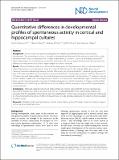Files in this item
Quantitative differences in developmental profiles of spontaneous activity in cortical and hippocampal cultures
Item metadata
| dc.contributor.author | Charlesworth, Paul | |
| dc.contributor.author | Cotterill, Ellese | |
| dc.contributor.author | Morton, Andrew | |
| dc.contributor.author | Grant, Seth | |
| dc.contributor.author | Eglen, Stephen J | |
| dc.date.accessioned | 2015-12-01T16:40:02Z | |
| dc.date.available | 2015-12-01T16:40:02Z | |
| dc.date.issued | 2015-01-28 | |
| dc.identifier | 167909942 | |
| dc.identifier | 5fb3aead-b714-48e1-8ebd-7f6d88a2e950 | |
| dc.identifier | 25626996 | |
| dc.identifier | 84924548257 | |
| dc.identifier.citation | Charlesworth , P , Cotterill , E , Morton , A , Grant , S & Eglen , S J 2015 , ' Quantitative differences in developmental profiles of spontaneous activity in cortical and hippocampal cultures ' , Neural Development , vol. 10 , no. 1 . https://doi.org/10.1186/s13064-014-0028-0 | en |
| dc.identifier.issn | 1749-8104 | |
| dc.identifier.uri | https://hdl.handle.net/10023/7876 | |
| dc.description | PC and AM were supported by the Wellcome Trust Genes to Cognition programme. PC received additional support from the Biotechnology and Biological Sciences Research Council (BB/H008608/1). EC was supported by a Wellcome Trust PhD studentship and Cambridge Biomedical Research Centre studentship. SJE was supported by an Engineering and Physical Sciences Research Council grant (EP/E002331/1). | en |
| dc.description.abstract | Background Neural circuits can spontaneously generate complex spatiotemporal firing patterns during development. This spontaneous activity is thought to help guide development of the nervous system. In this study, we had two aims. First, to characterise the changes in spontaneous activity in cultures of developing networks of either hippocampal or cortical neurons dissociated from mouse. Second, to assess whether there are any functional differences in the patterns of activity in hippocampal and cortical networks. Results We used multielectrode arrays to record the development of spontaneous activity in cultured networks of either hippocampal or cortical neurons every 2 or 3 days for the first month after plating. Within a few days of culturing, networks exhibited spontaneous activity. This activity strengthened and then stabilised typically around 21 days in vitro. We quantified the activity patterns in hippocampal and cortical networks using 11 features. Three out of 11 features showed striking differences in activity between hippocampal and cortical networks: (1) interburst intervals are less variable in spike trains from hippocampal cultures; (2) hippocampal networks have higher correlations and (3) hippocampal networks generate more robust theta-bursting patterns. Machine-learning techniques confirmed that these differences in patterning are sufficient to classify recordings reliably at any given age as either hippocampal or cortical networks. Conclusions Although cultured networks of hippocampal and cortical networks both generate spontaneous activity that changes over time, at any given time we can reliably detect differences in the activity patterns. We anticipate that this quantitative framework could have applications in many areas, including neurotoxicity testing and for characterising the phenotype of different mutant mice. All code and data relating to this report are freely available for others to use. | |
| dc.format.extent | 10 | |
| dc.format.extent | 818189 | |
| dc.language.iso | eng | |
| dc.relation.ispartof | Neural Development | en |
| dc.subject | Multielectrode array | en |
| dc.subject | Spontaneous activity | en |
| dc.subject | Cortex | en |
| dc.subject | Hippocampus | en |
| dc.subject | Principal component analysis | en |
| dc.subject | Support vector machine | en |
| dc.subject | Classification tree | en |
| dc.subject | RC0321 Neuroscience. Biological psychiatry. Neuropsychiatry | en |
| dc.subject | NDAS | en |
| dc.subject.lcc | RC0321 | en |
| dc.title | Quantitative differences in developmental profiles of spontaneous activity in cortical and hippocampal cultures | en |
| dc.type | Journal article | en |
| dc.contributor.institution | University of St Andrews. School of Physics and Astronomy | en |
| dc.identifier.doi | 10.1186/s13064-014-0028-0 | |
| dc.description.status | Peer reviewed | en |
This item appears in the following Collection(s)
Items in the St Andrews Research Repository are protected by copyright, with all rights reserved, unless otherwise indicated.

